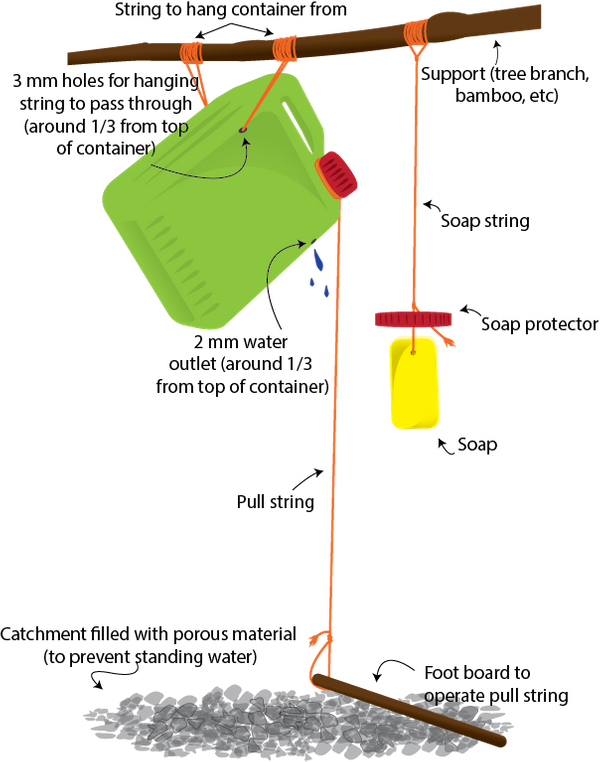The current COVID-19 global pandemic has reignited conversation around the importance of handwashing to prevent the spread of disease. While a seemingly easy task for most of us, this is no small feat for the 785 million people who live without basic water services in their homes (WHO, 2017). Thanks to the work of Dr. Jim Watt and Jackson Masawi at the University of Zimbabwe, there is a simple solution to handwashing in areas with limited water access: the tippy tap. Although many of us are accustomed to washing our hands with copious amounts of water from our sink faucet (help save water by turning off your faucet while you scrub!), you can effectively wash your hands with as little as 40 ml of water by using a tippy tap (DDOnline, 1993).

Figure 2. Tippy tap parts diagram with optional foot pedal and catchment included. Source: Cody Kiefer, inspired by Lifewater International, 2005.
You can make a tippy tap from readily available materials:
- an empty jug
- a water bottle (to cover and protect the soap)
- string
- a bar of soap
- a stick (optional)
- gravel or other porous material (optional)
Instructions on how to assemble a tippy tap can be found online; see the bottom of this article for links to illustrated guides. In a matter of minutes, you can have a fully functional handwashing station (Figure 2). Best of all, you can upgrade your tippy tap to run hands-free by making a foot pedal out of a stick. The foot pedal makes handwashing easier and more effective. In areas with poor drainage, adding a gravel/porous material in a shallow pit under the tippy tap will allow the water to slowly drain into the surrounding soil, preventing the formation of a puddle where mosquitos could breed.
Once your tippy tap is complete, use it while following the Centers for Disease Control’s five steps for washing hands (CDC, 2020):
- Wet your hands with clean water.
- Lather your hands by rubbing them together with the soap. Do not forget to lather the backs of your hands, between your fingers, and under your nails.
- Scrub your hands for at least 20 seconds.
- Rinse your hands.
- Dry your hands with a clean towel or allow to air dry.
Making and using a tippy tap can be simple, though being aware of potential issues in cultural adoption is important (SPRING/Bangladesh, 2015). Handwashing is a proven front-line method to mitigate disease transmission.
Guides for tippy tap construction
Westra, M.T. and H. Holtslag. 2008. How to make a Tippy Tap: a hygienic handwashing device with running water. Werkgroep OntwikkelingsTechnieken (WOT) University of Twente, the Netherlands.
Build a Tippy Tap Manual. http://www.tippytap.org/build-a-tippy-tap-manual.
Lifewater International. 2005. Tippy Tap II.
References
Centers for Disease Control and Prevention (CDC), When and How to Wash Your Hands. Accessed March 26, 2020.
DDOnline (Dialogue on Diarrhoea Online). 1993. Tippy Tap Saves Water, Issue no. 54. Accessed online at https://rehydrate.org/dd/dd54.htm.
SPRING/Bangladesh. 2015. Use of Tippy Taps and Handwashing Practices in Southern Bangladesh: Qualitative Study. Arlington, VA: Strengthening Partnerships, Results, and Innovations in Nutrition Globally (SPRING) project.
World Health Organization, Drinking Water Fact Sheet for 2017. Accessed online at https://www.who.int/en/news-room/fact-sheets/detail/drinking-water.
Cite as:
Toevs, E. 2020. A Tip of the Hat to the Tippy Tap. ECHO Development Notes no. 147